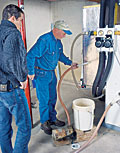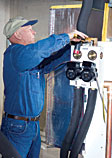
They chose an Energy Star®-certified builder and committed, early on, to installing a high-efficiency geothermal HVAC system.
Most geothermal loop installations are routinely completed in a day or two, but occasionally geothermal installations like the Heindrichs' offer unique challenges to the contractor and the loop installer.
The tract home builder in this case was unwilling to permit several tweaks to the design during the construction phase, including installation of the geo system. The Heindrichs had to wait until final occupancy before modifications could be made. The mechanical equipment installed by the builder was a 90 percent natural gas furnace with a/c system; all of it packed into a small utility closet.
Adapting geothermal to their home called for some creativity. Fortunately, the Heindrichs' research led them to Jeff Persons, president of Plain City, Ohio-based Geo Source One Inc., one of the state's leading mechanical contracting firms specializing in geothermal and radiant heat systems. Persons - a hydrogeologist who once served as a research associate for the National Ground Water Association (NGWA) and instructor for National Water Well Association (NWWA) certification programs - performed a detailed site review and recognized that the tight confines of the mechanical room called for the use of a split-system geothermal unit with a coil installed on top of the existing gas furnace, and the geothermal compressor section installed as a replacement for the outdoor condensing unit.
"Most geothermal systems are packaged units that don't require connections to other HVAC equipment," said Persons. "In this case we needed to adapt the geothermal equipment to the existing system."
APPLICATION SPECIFICS
A WaterFurnace dual-capacity system was chosen as the most cost-effective means to apply geothermal to the existing system. Under Persons' supervision, the drilling contractor drilled three 150-foot vertical heat exchanger loops.Following that, a Geo Source One crew installed the high-efficiency, dual-fuel split system by connecting the vertical loops to the geothermal unit. Connective trenches were dug to contain the refrigerant lines that now connect the outdoor geothermal unit with the interior heating and a/c coil.
"We were so much more comfortable knowing that the system uses fossil fuels only for auxiliary heat," said Laura Heindrichs. "Our previous home was an old, drafty, gas guzzler."
The Heindrichs' first energy bills have been about $100 less per month than they were in their previous, smaller home. "We're delighted with the system, our comfort within the home and, of course, the energy savings we're seeing," said Laura. "We don't know yet what our neighbors are paying for fuel during cold winter months, but judging from their curiosity about the geothermal system we installed, it's probably substantial."

SYSTEM SPECIFICS
The Heindrichs' geothermal system has an EER greater than 20. The unit's COP of 4.0 (400 percent efficiency) gives them four units of energy for every unit of electricity it consumes.The system taps the earth's energy through direct contact with the soil, rock, and water below the earth's surface. Depending on the season of year, the heat pump system harvests or rejects heat directly from its contact with the earth, which maintains an average, year-round, underground temperature of about 53°F in central Ohio.
While air-source heat pumps rely on a wide range of ambient air temperatures, the earth's constant temperature provides a more favorable source for heating and cooling.
"Most geothermal systems operate at ranges of 250-400 percent efficiency," said Persons. "Systems of even higher efficiency are available for residential and commercial application.
"With the variety of options available for installation of the earth field," he said, "and the highest operational system efficiencies, up into the 400-450 percent range, geo systems are a great choice for many homes or buildings, especially now as energy rates skyrocket."
Persons said he has seen a trend developing during the past few years. "Homeowners with gas-fired furnaces are fed up with increasing fuel costs, so they're asking about geothermal retrofits. We've been doing a lot more of these recently where the existing system's fan unit is used as the new geothermal system's air handler, and the gas burners need only operate for supplemental heat in the very coldest of weather conditions."

CLOSED LOOP VS. OPEN LOOP
"Only a small amount of electricity is needed to power geo systems," said Bruce Ritchey, president and chief executive officer of Fort Wayne, Ind.-based WaterFurnace. "The rest of the process uses the free, clean, and renewable energy that's tapped just below the earth's surface."There are two basic types of water-source geo systems: open loop and closed loop. An open-loop system typically pumps water out of a deep well, extracts heat from it (or, in the summer, rejects heat into it), then moves that water back into another well, a pond, or a river.
A closed-loop system uses a continuous loop of buried tubing as a heat exchanger. The tubing is connected to the indoor heat pump to form a sealed, underground loop through which an antifreeze solution is circulated. Unlike an open-loop system which uses water from a well, a closed-loop system recirculates its heat-transferring solution in the pressurized pipe. Many closed loops are trenched horizontally in yards adjacent to the home, set in vertical well bores, or submerged into a pond.
Comparing the two water-source units, an open-loop system tends to be more efficient because it simply transfers thermal energy to and from a steady stream of subterranean water, the manufacturer said. It's not recirculated as with a closed-loop system.

ALL-IN-ONE SYSTEM
Many geothermal systems also offer the ability to heat domestic water by one of two means: through integrated full-time water preheating, or through desuperheating water."It's been a real education for both of us," said Jeff Heindrichs. "We're certain we made the right move to install geothermal, especially considering that we expect to be in this home a long time. We're very pleased with the system. We recommend geothermal and Geo Source One to anyone who asks."
Sidebar: How Geothermal Works
Ground-source heat pumps have been installed for more than 30 years and are recognized as one of the most highly efficient heating-cooling systems available today."Geothermal heat pump technology offers a renewable energy solution that's right for almost any home," said Bruce Ritchey, president and chief executive officer of WaterFurnace (Fort Wayne, Ind.).
"Thermal energy of sufficient temperatures anywhere in the United States and Canada is harvested from the earth and transferred into buildings by a heat pump that provides heating and cooling."
Installation requires an acre or more of land, or the ability to drill holes or tap an existing water source (pond or lake).
A geothermal unit works like a conventional heat pump to cool a home in the summer and heat it in the winter. The key difference between an air-source heat pump (which can't heat a home efficiently when outdoor temperatures dip below 30°F) and a geothermal heat pump is that the geothermal unit harvests stable and renewable heat from beneath the earth's surface. In the summertime, the cycle is reversed and heat is released into the ground.
As a result, a geothermal unit saves energy, which reduces greenhouse gas emissions and can cut utility bills by up to 70 percent. Little maintenance is required, the manufacturer said.
Publication date: 07/24/2006



